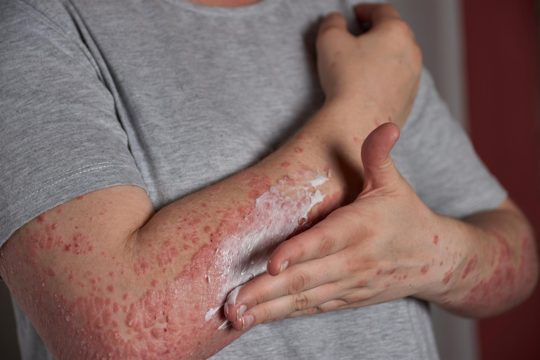Understanding Pityriasis Rosea (Christmas Tree Rash): Causes, Symptoms, Diagnosis, Treatment, and Complications
Pityriasis Rosea, often referred to as the 'Christmas Tree Rash', is a common skin condition that predominantly affects children and young adults. This condition manifests as a rash that may spread across the body, often resembling the shape of a Christmas tree. Despite its prevalence, it remains largely misunderstood, with many individuals unaware of its causes, symptoms, and treatment options.

This article aims to provide an in-depth understanding of Pityriasis Rosea, exploring its causes, symptoms, diagnosis, treatment options, potential complications, and key takeaways. Stepping into the world of dermatology, let us shine a spotlight on Pityriasis Rosea or the 'Christmas Tree Rash', a skin condition that is as intriguing as its name. Predominantly affecting the younger demographic, it paints a unique pattern on the body, reminiscent of a Christmas tree. Surprisingly, despite its common occurrence, it is often cloaked in mystery, leaving many in the dark about its roots, signs, and healing paths.
In this article, we strive to unravel the enigma of Pityriasis Rosea. Expect a comprehensive exploration of its origin, symptoms, diagnostic approaches, treatment avenues, potential complications, and essential insights. Welcome to a journey of discovery and understanding.
What is Pityriasis Rosea?
Pityriasis Rosea is a skin rash that is usually benign and self-limiting. It is most common in children and young adults, and appears as a single, large oval patch on the chest, abdomen, or back, followed by a series of smaller patches that can spread in a pattern that resembles the branches of a Christmas tree.
Despite the discomfort it may cause, Pityriasis Rosea typically resolves without treatment within 6 to 8 weeks. Pityriasis Rosea, despite its benign nature, can be a cause for concern due to its sudden and noticeable appearance, predominantly in children and young adults. This skin rash typically presents itself first as a single, large oval patch, often found on the chest, abdomen, or back.
This initial 'herald patch' is then followed by a flurry of smaller patches. These subsequent rashes spread in an intriguing pattern, akin to the elegant branches of a Christmas tree.
It's important to note that while the rash can cause discomfort, it's typically not a cause for alarm. In most cases, Pityriasis Rosea will resolve on its own accord, fading away without treatment within 6 to 8 weeks, leaving no trace of its fleeting presence.
What are the Symptoms of Pityriasis Rosea?
The initial symptoms of Pityriasis Rosea may include a single, large pink or red patch, known as a 'herald patch', which typically appears on the chest, abdomen, or back. This is followed by a rash of smaller patches, which may spread to the neck, limbs, and occasionally the face. These patches may be itchy and can sometimes be accompanied by mild symptoms of viral infection, such as fatigue, headache, or a low-grade fever.
The journey with Pityriasis Rosea often starts with a solitary, vibrant pink or crimson herald patch, usually making its debut on the chest, abdomen, or back. This sets the stage for a subsequent outbreak of smaller patches, expanding their territory to the neck, limbs, and on rare instances, the face.
These patches often carry an itch, acting as constant reminders of their presence. They may also choose to bring along companions - mild viral symptoms such as fatigue, a nagging headache, or a low-grade fever, subtly impacting your daily life.
What Causes Pityriasis Rosea?
The exact cause of Pityriasis Rosea is unknown, but it is thought to be related to a viral infection, particularly reactivation of certain human herpesviruses. It is not believed to be contagious, and there is no evidence to suggest that it can be spread through direct skin-to-skin contact.
Pityriasis Rosea is not related to personal hygiene, diet, or lifestyle, and it does not seem to run in families. Despite the mystery surrounding Pityriasis Rosea's exact cause, researchers believe it may be tied to a viral infection, specifically the reactivation of certain human herpesviruses. Yet, it's important to note that this skin condition isn't considered contagious.
There's no existing evidence indicating it can spread through direct skin contact. Moreover, Pityriasis Rosea isn't associated with personal hygiene, diet, or lifestyle, nor does it appear to have a genetic component. Thus, anyone can be afflicted, regardless of their health habits or family history.
How is Pityriasis Rosea Diagnosed?
Pityriasis Rosea is typically diagnosed based on the appearance and pattern of the rash. A medical professional may perform a physical examination and ask about your symptoms and medical history. In some cases, a skin biopsy or blood test may be used to rule out other conditions that can cause similar symptoms, such as psoriasis, eczema, or ringworm.
Pityriasis Rosea, a skin condition often mistaken for other ailments, is generally diagnosed by closely examining the unique rash pattern and visual elements it presents. To ensure an accurate diagnosis, a healthcare practitioner will conduct a thorough physical analysis, delve into your symptomatology, and investigate your medical history. The diagnostic process may also encompass a skin biopsy or blood tests, employed to eliminate the possibility of other disorders with similar manifestations, including psoriasis, eczema, or ringworm. Thus, a comprehensive and meticulous evaluation is the key to unmasking this elusive condition.
Treatment Options for Pityriasis Rosea
The main goal of treatment for Pityriasis Rosea is to relieve symptoms, particularly itching. As the condition usually resolves on its own within 6 to 8 weeks, treatment may not always be necessary. However, if symptoms are severe, medical professionals may recommend topical corticosteroids or antihistamines to reduce itching, or light therapy to speed up the healing process.
It's important to consult a healthcare provider to determine the best treatment plan for you. The primary objective in managing Pityriasis Rosea revolves around alleviating discomforting symptoms, notably the incessant itchiness. While the condition typically dissipates within a 6 to 8 week timeframe, making intervention unnecessary in some cases, severe symptoms might compel medical intervention. This could involve the application of topical corticosteroids or antihistamines to curtail itchiness, or even resorting to light therapy to expedite recovery.
Consequently, it's crucial to engage a healthcare professional's expertise to tailor a treatment strategy that best suits your unique needs.
Possible Complications of Pityriasis Rosea
While Pityriasis Rosea is usually benign and self-limiting, it can sometimes lead to complications. These may include severe itching, which can interfere with sleep and daily activities, and post-inflammatory hyperpigmentation, where the skin remains discolored even after the rash has cleared. Rarely, Pityriasis Rosea can recur, or be associated with bacterial skin infections if the skin becomes broken from severe scratching.
It's worth noting that Pityriasis Rosea, although largely benign and self-resolving, could occasionally provoke complications. These might range from intense itching, disrupting both sleep patterns and daily routines, to post-inflammatory hyperpigmentation, leaving a persistent skin discoloration even after the rash has disappeared.
In infrequent cases, Pityriasis Rosea may reappear, or be linked with bacterial skin infections, particularly if the skin becomes damaged due to relentless scratching. Hence, it's vital to address this condition promptly and effectively.
The Takeaway
Pityriasis Rosea is a common skin condition that typically resolves without treatment within 6 to 8 weeks. Although it can cause discomfort and concern due to its appearance, it is generally benign and does not pose a serious threat to health. If you or a loved one are experiencing symptoms of Pityriasis Rosea, consult with a healthcare provider for an accurate diagnosis and treatment plan. Remember, knowledge is power when it comes to managing your health.
Pityriasis Rosea, a widespread skin condition, is typically transient, disappearing naturally within a 6 to 8-week timeframe. Nevertheless, its distinctive manifestation may trigger discomfort and unease, despite it being primarily harmless, posing no significant health risks.
If you or someone dear to you are experiencing symptoms reminiscent of Pityriasis Rosea, it's imperative to seek professional medical advice for a precise diagnosis and personalized treatment plan. Always bear in mind that being informed and cognizant about your health condition is a potent tool in managing your health effectively.
About us
Welcome to HealsHub! Your go-to source for all things related to health and wellness! We're here to help you lead a healthier, happier life by providing you with the latest news, research, and advice on topics like nutrition, fitness, mental health, and more. Our mission is to empower you to take control of your health and well-being through education and inspiration. Whether you're looking to lose weight, build muscle, manage stress, or simply learn more about how your body works, you'll find everything you need right here on healshub.com. We believe that everyone deserves to live a healthy, fulfilling life, and we're committed to providing you with the tools and resources you need to achieve your goals. So take a look around, explore our articles and resources, and start your journey towards better health today!

